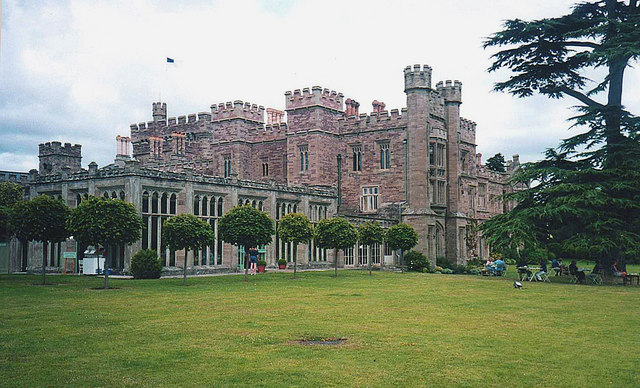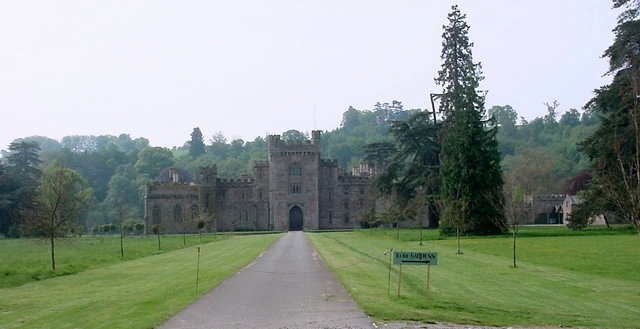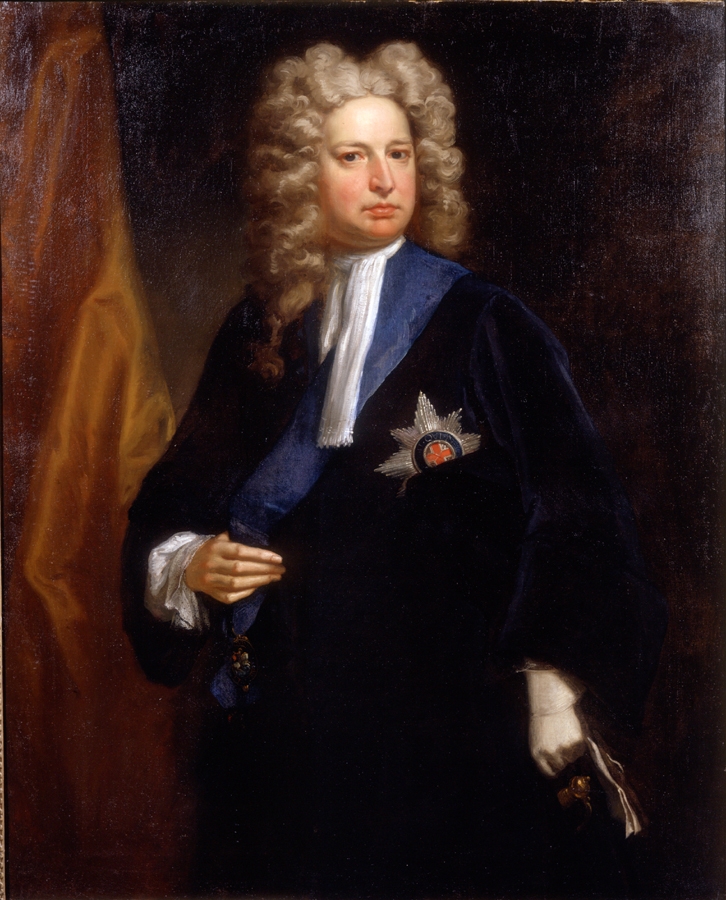|
Humphrey Coningsby
Humphrey Coningsby (born ca. 1623) was an English politician who sat in the House of Commons from 1641 to 1644. He supported the Royalist side in the English Civil War. Coningsby was the eldest son of Fitzwilliam Conningsby, of Hampton Court, Herefordshire, and Cicely Nevill, daughter of Henry Nevill, 9th Baron Bergavenny. He matriculated at Lincoln College, Oxford on 23 February 1638, aged 15. He was of the Middle Temple in 1639. In November 1641, Coningsby was elected Member of Parliament for Herefordshire in the Long Parliament, replacing his father who had been expelled as a monopolist. He supported the King and was disabled from sitting in parliament on 22 January 1644. Coningsby married Lettice Loftus, eldest daughter of Sir Arthur Loftus of Rathfarnham, Ireland. Their son Thomas became Earl Coningsby Earl Coningsby was a title in the Peerage of Great Britain. It was created in 1719 for Thomas Coningsby, 1st Baron Coningsby, with remainder to his eldest daught ... [...More Info...] [...Related Items...] OR: [Wikipedia] [Google] [Baidu] |
House Of Commons Of England
The House of Commons of England was the lower house of the Parliament of England (which incorporated Wales) from its development in the 14th century to the union of England and Scotland in 1707, when it was replaced by the House of Commons of Great Britain after the 1707 Act of Union was passed in both the English and Scottish parliaments at the time. In 1801, with the union of Great Britain and Republic of Ireland, Ireland, that house was in turn replaced by the House of Commons of the United Kingdom. Origins The Parliament of England developed from the Magnum Concilium that advised the English monarch in medieval times. This royal council, meeting for short periods, included ecclesiastics, noblemen, and representatives of the county, counties (known as "knights of the shire"). The chief duty of the council was to approve taxes proposed by the Crown. In many cases, however, the council demanded the redress of the people's grievances before proceeding to vote on taxation. Thus ... [...More Info...] [...Related Items...] OR: [Wikipedia] [Google] [Baidu] |
Arthur Loftus
Sir Arthur Loftus (died 27 May 1665) was an Anglo-Irish politician and landowner. He was the son of Sir Adam Loftus and Jane Vaughan. His grandfather was Sir Dudley Loftus. He served as the Member of Parliament for County Wexford in the 1639–49 parliament and was Provost Marshal of Ulster. He was knighted by Charles II. He lived at Rathfarnham, County Dublin. Loftus married Lady Dorothy Boyle, daughter of Richard Boyle, 1st Earl of Cork and Catherine Fenton, in 1627. However, the Earl of Cork in his diaries records their marriage on Shrove Monday, 13 February 1632 (1631 Old Style). Their son was Adam Loftus, 1st Viscount Lisburne and their daughter, Lettice, married Humphrey Coningsby. References Date of birth unknown 1665 deaths 17th-century Anglo-Irish people 17th-century Irish landowners Irish MPs 1639–1649 Knights Bachelor Arthur Arthur is a common male given name of Brittonic languages, Brythonic origin. Its popularity derives from it being the name of th ... [...More Info...] [...Related Items...] OR: [Wikipedia] [Google] [Baidu] |
Year Of Death Missing
A year or annus is the orbital period of a planetary body, for example, the Earth, moving in its orbit around the Sun. Due to the Earth's axial tilt, the course of a year sees the passing of the seasons, marked by change in weather, the hours of daylight, and, consequently, vegetation and soil fertility. In temperate and subpolar regions around the planet, four seasons are generally recognized: spring, summer, autumn and winter. In tropical and subtropical regions, several geographical sectors do not present defined seasons; but in the seasonal tropics, the annual wet and dry seasons are recognized and tracked. A calendar year is an approximation of the number of days of the Earth's orbital period, as counted in a given calendar. The Gregorian calendar, or modern calendar, presents its calendar year to be either a common year of 365 days or a leap year of 366 days, as do the Julian calendars. For the Gregorian calendar, the average length of the calendar year (the me ... [...More Info...] [...Related Items...] OR: [Wikipedia] [Google] [Baidu] |
1623 Births
Sixteen or 16 may refer to: *16 (number), the natural number following 15 and preceding 17 *one of the years 16 BC, AD 16, 1916, 2016 Films * '' Pathinaaru'' or ''Sixteen'', a 2010 Tamil film * ''Sixteen'' (1943 film), a 1943 Argentine film directed by Carlos Hugo Christensen * ''Sixteen'' (2013 Indian film), a 2013 Hindi film * ''Sixteen'' (2013 British film), a 2013 British film by director Rob Brown Music *The Sixteen, an English choir * 16 (band), a sludge metal band * Sixteen (Polish band), a Polish band Albums * ''16'' (Robin album), a 2014 album by Robin * 16 (Madhouse album), a 1987 album by Madhouse * ''Sixteen'' (album), a 1983 album by Stacy Lattisaw *''Sixteen'' , a 2005 album by Shook Ones * ''16'', a 2020 album by Wejdene Songs * "16" (Sneaky Sound System song), 2009 * "Sixteen" (Thomas Rhett song), 2017 * "Sixteen" (Ellie Goulding song), 2019 *"16", by Craig David from ''Following My Intuition'', 2016 *"16", by Green Day from ''39/Smooth'', 1990 *"16", ... [...More Info...] [...Related Items...] OR: [Wikipedia] [Google] [Baidu] |
Fitzwilliam Coningsby
Fitzwilliam Coningsby (died August 1666) was an English politician who sat in the House of Commons in 1621 and in 1640. He supported the Royalist cause in the English Civil War. Biography Coningsby was born at Hampton Court, Herefordshire, the eldest son of the eminent soldier and politician Sir Thomas Coningsby, and his wife Phillipa Fitzwilliam, daughter of Sir William Fitzwilliam of Milton. He was High Steward of Leominster in 1605. He was educated at Hereford Cathedral School. In 1621, Coningsby was elected Member of Parliament for Herefordshire. In 1625 he inherited Hampton Court on the death of his father. He was High Sheriff of Herefordshire in 1626-27 and 1642-43. In November 1640, Coningsby was elected again as MP for Herefordshire in the Long Parliament, but was expelled in 1641 for being a monopolist, He was one of the "Nine Worthies" - nine justices who formed the royalist leadership in Herefordshire in the summer of 1642. The others were Sir William Croft, Wall ... [...More Info...] [...Related Items...] OR: [Wikipedia] [Google] [Baidu] |
Robert Harley (died 1656)
Robert Harley may refer to: Politicians *Robert Harley (1579–1656), English statesman, Member of Parliament for Radnor and Herefordshire *Robert Harley (died 1673) (1626–1673), British Member of Parliament for Radnor *Robert Harley, 1st Earl of Oxford and Earl Mortimer (1661–1724), Member of Parliament for Radnor and Tregony *Robert Harley (c. 1706 – 1774), Member of Parliament for Leominster, 1731–1741 and 1742–1747, and Droitwich *Robert William Harley (1829–1892), British colonial administrator Others *Robert Harley (mathematician) (1828–1910), English Congregational minister *Robert Harley (writer), British comedy writer *Bob Harley (1888–1958), Canadian footballer *Rob Harley (born 1990), Scottish rugby union player {{hndis, Harley, Robert ... [...More Info...] [...Related Items...] OR: [Wikipedia] [Google] [Baidu] |
Dictionary Of National Biography
The ''Dictionary of National Biography'' (''DNB'') is a standard work of reference on notable figures from British history, published since 1885. The updated ''Oxford Dictionary of National Biography'' (''ODNB'') was published on 23 September 2004 in 60 volumes and online, with 50,113 biographical articles covering 54,922 lives. First series Hoping to emulate national biographical collections published elsewhere in Europe, such as the ''Allgemeine Deutsche Biographie'' (1875), in 1882 the publisher George Smith (1824–1901), of Smith, Elder & Co., planned a universal dictionary that would include biographical entries on individuals from world history. He approached Leslie Stephen, then editor of the ''Cornhill Magazine'', owned by Smith, to become the editor. Stephen persuaded Smith that the work should focus only on subjects from the United Kingdom and its present and former colonies. An early working title was the ''Biographia Britannica'', the name of an earlier eighteen ... [...More Info...] [...Related Items...] OR: [Wikipedia] [Google] [Baidu] |
Earl Coningsby
Earl Coningsby was a title in the Peerage of Great Britain. It was created in 1719 for Thomas Coningsby, 1st Baron Coningsby, with remainder to his eldest daughter (by his second wife Lady Frances Jones), Margaret Newton, 1st Viscountess Coningsby, and the heirs male of her body. He was the great-grandson of the soldier and politician Sir Thomas Coningsby. Coningsby had already been created Baron Coningsby, of Clanbrassil, in the Peerage of Ireland in 1693, with normal remainder to heirs male, and Baron Coningsby in the Peerage of Great Britain in 1716, with the similar remainder as for the earldom. On Lord Coningsby's death in 1729 he was succeeded in the Irish barony of 1692 by his grandson Richard Coningsby, the second Baron, the son of one of Coningsby's sons from his first marriage to Barbara Georges. However, Richard died already the same year, when the barony became extinct. Lord Coningsby was succeeded in the English barony and the earldom according to the special remain ... [...More Info...] [...Related Items...] OR: [Wikipedia] [Google] [Baidu] |
Thomas Coningsby, 1st Earl Coningsby
Thomas Coningsby, 1st Earl Coningsby PC (2 November 1656 – 1 May 1729) of Hampton Court Castle, Herefordshire, was an English politician who sat in the House of Commons at various times from 1679 until 1716 when he was created a peer and sat in the House of Lords Early life Coningsby was the son of Humphrey Coningsby of Hampton Court, and his wife Lettice Loftus, eldest daughter of Sir Arthur Loftus of Rathfarnham, Ireland. He was the great-grandson of Sir Thomas Coningsby. In 1679, Coningsby was elected Member of Parliament for Leominster. He represented the constituency continuously until 1710, He was re-elected in 1715 and sat until his elevation to the British peerage. Royal allegiance William III Coningsby was an ardent supporter of the revolution of 1688, and opposed the Jacobite faction. Coningsby accompanied William III to Ireland, and was present at the battle of the Boyne where the King was injured. He was appointed joint receiver and Paymaster-General of t ... [...More Info...] [...Related Items...] OR: [Wikipedia] [Google] [Baidu] |
Rathfarnham
Rathfarnham () is a Southside suburb of Dublin, Ireland. It is south of Terenure, east of Templeogue, and is in the postal districts of Dublin 14 and 16. It is within the administrative areas of both Dún Laoghaire–Rathdown County Council and South Dublin County Council. Located within the historical baronies of Rathdown and Uppercross, Rathfarnham village originally developed around a fortification overlooking a ford on the River Dodder. From the medieval period, Rathfarnham was on the perimeter of the Pale (the area of Anglo-Norman influence in Ireland, centred on Dublin), and a number of defensive structures were built in the area. Rathfarnham Castle, a fortified house, was built in the late 16th century. Developed around these structures, by the 19th century there were a number of mills operating in the area, and Rathfarnham was still somewhat rural by the early 20th century. During the 20th century, with the expansion of metropolitan Dublin, Rathfarnham became a lar ... [...More Info...] [...Related Items...] OR: [Wikipedia] [Google] [Baidu] |
Long Parliament
The Long Parliament was an English Parliament which lasted from 1640 until 1660. It followed the fiasco of the Short Parliament, which had convened for only three weeks during the spring of 1640 after an 11-year parliamentary absence. In September 1640, King Charles I issued writs summoning a parliament to convene on 3 November 1640.This article uses the Julian calendar with the start of year adjusted to 1 January – for a more detailed explanation, see old style and new style dates: differences between the start of the year. He intended it to pass financial bills, a step made necessary by the costs of the Bishops' Wars in Scotland. The Long Parliament received its name from the fact that, by Act of Parliament, it stipulated it could be dissolved only with agreement of the members; and those members did not agree to its dissolution until 16 March 1660, after the English Civil War and near the close of the Interregnum.. The parliament sat from 1640 until 1648, when it was p ... [...More Info...] [...Related Items...] OR: [Wikipedia] [Google] [Baidu] |
Cavaliers
The term Cavalier () was first used by Roundheads as a term of abuse for the wealthier royalist supporters of King Charles I and his son Charles II of England during the English Civil War, the Interregnum, and the Restoration (1642 – ). It was later adopted by the Royalists themselves. Although it referred originally to political and social attitudes and behaviour, of which clothing was a very small part, it has subsequently become strongly identified with the fashionable clothing of the court at the time. Prince Rupert, commander of much of Charles I's cavalry, is often considered to be an archetypal Cavalier. Etymology Cavalier derives from the same Latin root as the Italian word and the French word (as well as the Spanish word ), the Vulgar Latin word '' caballarius'', meaning 'horseman'. Shakespeare William Shakespeare ( 26 April 1564 – 23 April 1616) was an English playwright, poet and actor. He is widely regarded as the greatest writer in the English langu ... [...More Info...] [...Related Items...] OR: [Wikipedia] [Google] [Baidu] |






.jpg)

